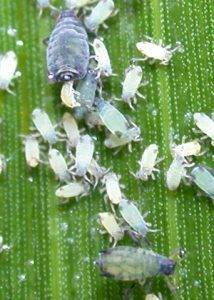Corn Aphids
Corn aphids have the ability to negatively impact yield end of year. Proper identification and management can protect your crop.
Identification
Corn aphids have a blue-green to gray appearance and are 1/16 inch in length. Aphids extract sap from corn plants and excrete honeydew. The honeydew creates sooty-looking mold that can interfere with pollination.
As opposed to laying eggs, female aphids reproduce by giving birth to nymphs. The insects can build large colonies comprised of more than one species such as bird-cherry oat aphids. Aphids are most often wingless, but when the size of their colonies begin to grow, some can form wings to migrate to other corn plants. Corn leaf aphids cannot overwinter and usually migrate to southern states ahead of the cold months.
Scouting and Implications
Aphids will begin to appear in corn around mid-June and early July. Mature aphids can be found near the tassels, silks and the base of the corn stalk. The insects predominately live in the whorls where they are protected from outside elements. Infected corn plants may exhibit stunting or wilting and curling of the leaves
When scouting for aphids, select 20 non-consecutive plants from five different areas of the field. Unroll the whorl to count the number of insects present. The general treatment threshold advised by Iowa State University is when 50% of corn plants have more than 100 aphids per plant.
Overall, aphid infestations have been found to reduce grain quality and decrease kernel size. A study from Penn State University finds that 30-40% of aphid-infested corn stalks will become barren or earless. Drought stress can also worsen the impacts of aphid feeding and should be included when considering a treatment plan.
Treatment Options
The best time to begin manage aphid-infested corn is two to three weeks prior to tasseling. Corn plants with aphid colonies above the ear are more susceptible to yield loss than plants with aphids found below the ear.
Since aphids mainly colonize inside corn whorls, spraying insecticides is not the most effective solution. Insecticide application is most effective when aphids are found on the outermost areas of leaves. If corn plants that have reached the hard dent stage, applying insecticides will not pay.
Fungi and other beneficial insects including lacewings and lady beetles can reduce aphid populations. Look for signs of bloating or discoloration in aphids – this could be evidence of fungi at work. If over 20% of aphids appear to be parasitized, consider holding off on a management plan. Be sure to talk with your local Latham representative to develop an effective treatment strategy for managing aphids.
